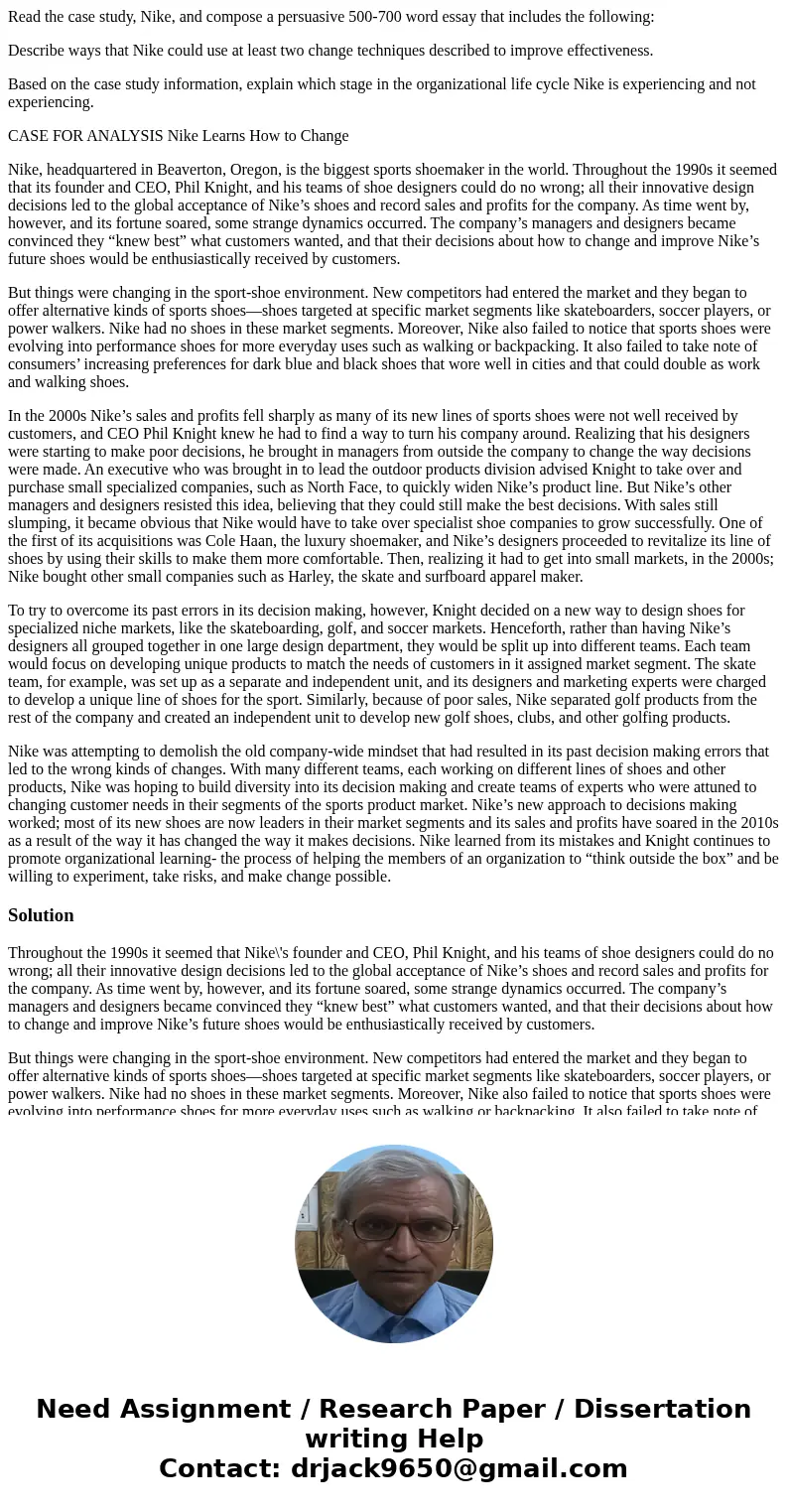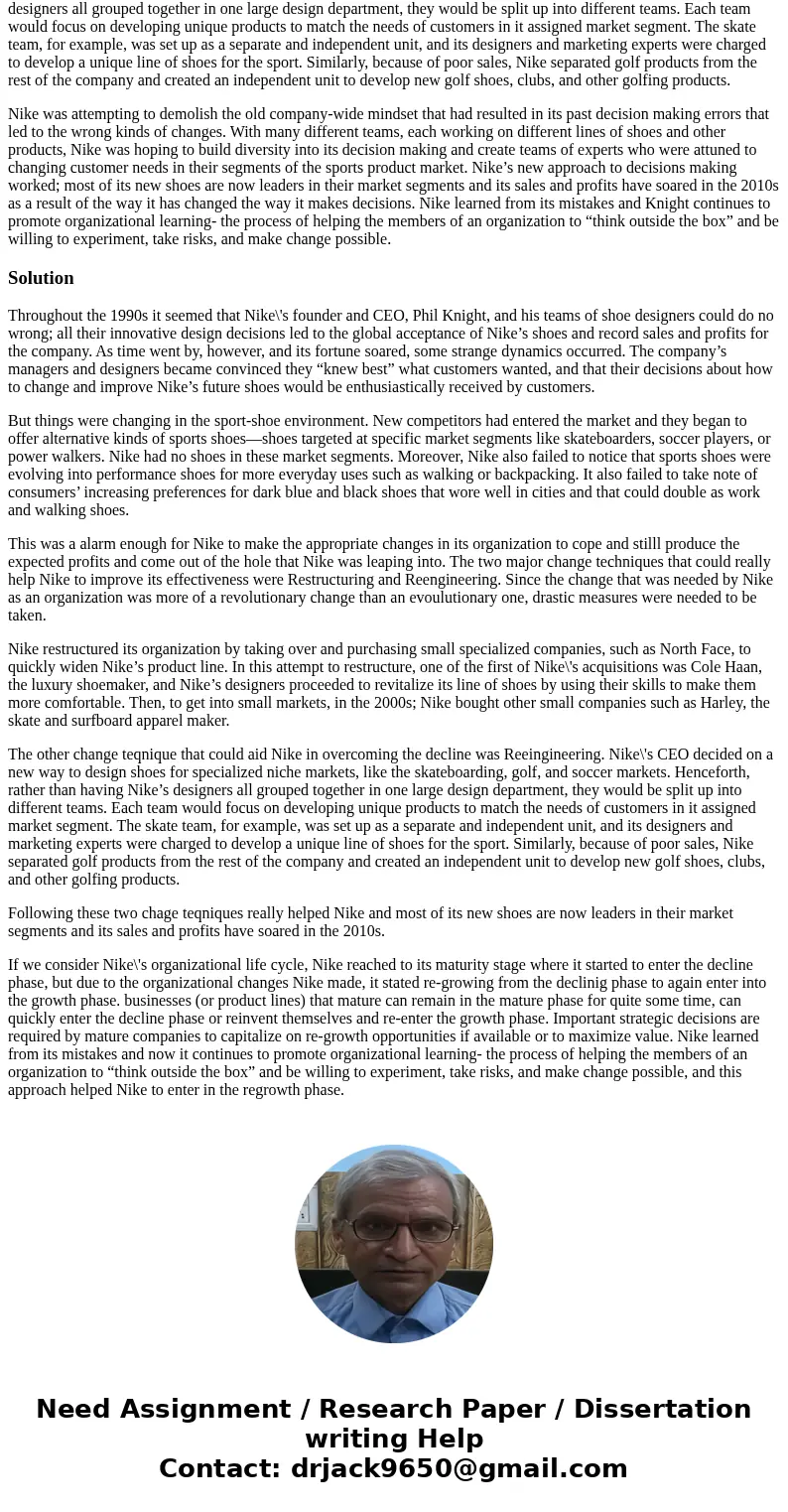Read the case study Nike and compose a persuasive 500700 wor
Read the case study, Nike, and compose a persuasive 500-700 word essay that includes the following:
Describe ways that Nike could use at least two change techniques described to improve effectiveness.
Based on the case study information, explain which stage in the organizational life cycle Nike is experiencing and not experiencing.
CASE FOR ANALYSIS Nike Learns How to Change
Nike, headquartered in Beaverton, Oregon, is the biggest sports shoemaker in the world. Throughout the 1990s it seemed that its founder and CEO, Phil Knight, and his teams of shoe designers could do no wrong; all their innovative design decisions led to the global acceptance of Nike’s shoes and record sales and profits for the company. As time went by, however, and its fortune soared, some strange dynamics occurred. The company’s managers and designers became convinced they “knew best” what customers wanted, and that their decisions about how to change and improve Nike’s future shoes would be enthusiastically received by customers.
But things were changing in the sport-shoe environment. New competitors had entered the market and they began to offer alternative kinds of sports shoes—shoes targeted at specific market segments like skateboarders, soccer players, or power walkers. Nike had no shoes in these market segments. Moreover, Nike also failed to notice that sports shoes were evolving into performance shoes for more everyday uses such as walking or backpacking. It also failed to take note of consumers’ increasing preferences for dark blue and black shoes that wore well in cities and that could double as work and walking shoes.
In the 2000s Nike’s sales and profits fell sharply as many of its new lines of sports shoes were not well received by customers, and CEO Phil Knight knew he had to find a way to turn his company around. Realizing that his designers were starting to make poor decisions, he brought in managers from outside the company to change the way decisions were made. An executive who was brought in to lead the outdoor products division advised Knight to take over and purchase small specialized companies, such as North Face, to quickly widen Nike’s product line. But Nike’s other managers and designers resisted this idea, believing that they could still make the best decisions. With sales still slumping, it became obvious that Nike would have to take over specialist shoe companies to grow successfully. One of the first of its acquisitions was Cole Haan, the luxury shoemaker, and Nike’s designers proceeded to revitalize its line of shoes by using their skills to make them more comfortable. Then, realizing it had to get into small markets, in the 2000s; Nike bought other small companies such as Harley, the skate and surfboard apparel maker.
To try to overcome its past errors in its decision making, however, Knight decided on a new way to design shoes for specialized niche markets, like the skateboarding, golf, and soccer markets. Henceforth, rather than having Nike’s designers all grouped together in one large design department, they would be split up into different teams. Each team would focus on developing unique products to match the needs of customers in it assigned market segment. The skate team, for example, was set up as a separate and independent unit, and its designers and marketing experts were charged to develop a unique line of shoes for the sport. Similarly, because of poor sales, Nike separated golf products from the rest of the company and created an independent unit to develop new golf shoes, clubs, and other golfing products.
Nike was attempting to demolish the old company-wide mindset that had resulted in its past decision making errors that led to the wrong kinds of changes. With many different teams, each working on different lines of shoes and other products, Nike was hoping to build diversity into its decision making and create teams of experts who were attuned to changing customer needs in their segments of the sports product market. Nike’s new approach to decisions making worked; most of its new shoes are now leaders in their market segments and its sales and profits have soared in the 2010s as a result of the way it has changed the way it makes decisions. Nike learned from its mistakes and Knight continues to promote organizational learning- the process of helping the members of an organization to “think outside the box” and be willing to experiment, take risks, and make change possible.
Solution
Throughout the 1990s it seemed that Nike\'s founder and CEO, Phil Knight, and his teams of shoe designers could do no wrong; all their innovative design decisions led to the global acceptance of Nike’s shoes and record sales and profits for the company. As time went by, however, and its fortune soared, some strange dynamics occurred. The company’s managers and designers became convinced they “knew best” what customers wanted, and that their decisions about how to change and improve Nike’s future shoes would be enthusiastically received by customers.
But things were changing in the sport-shoe environment. New competitors had entered the market and they began to offer alternative kinds of sports shoes—shoes targeted at specific market segments like skateboarders, soccer players, or power walkers. Nike had no shoes in these market segments. Moreover, Nike also failed to notice that sports shoes were evolving into performance shoes for more everyday uses such as walking or backpacking. It also failed to take note of consumers’ increasing preferences for dark blue and black shoes that wore well in cities and that could double as work and walking shoes.
This was a alarm enough for Nike to make the appropriate changes in its organization to cope and stilll produce the expected profits and come out of the hole that Nike was leaping into. The two major change techniques that could really help Nike to improve its effectiveness were Restructuring and Reengineering. Since the change that was needed by Nike as an organization was more of a revolutionary change than an evoulutionary one, drastic measures were needed to be taken.
Nike restructured its organization by taking over and purchasing small specialized companies, such as North Face, to quickly widen Nike’s product line. In this attempt to restructure, one of the first of Nike\'s acquisitions was Cole Haan, the luxury shoemaker, and Nike’s designers proceeded to revitalize its line of shoes by using their skills to make them more comfortable. Then, to get into small markets, in the 2000s; Nike bought other small companies such as Harley, the skate and surfboard apparel maker.
The other change teqnique that could aid Nike in overcoming the decline was Reeingineering. Nike\'s CEO decided on a new way to design shoes for specialized niche markets, like the skateboarding, golf, and soccer markets. Henceforth, rather than having Nike’s designers all grouped together in one large design department, they would be split up into different teams. Each team would focus on developing unique products to match the needs of customers in it assigned market segment. The skate team, for example, was set up as a separate and independent unit, and its designers and marketing experts were charged to develop a unique line of shoes for the sport. Similarly, because of poor sales, Nike separated golf products from the rest of the company and created an independent unit to develop new golf shoes, clubs, and other golfing products.
Following these two chage teqniques really helped Nike and most of its new shoes are now leaders in their market segments and its sales and profits have soared in the 2010s.
If we consider Nike\'s organizational life cycle, Nike reached to its maturity stage where it started to enter the decline phase, but due to the organizational changes Nike made, it stated re-growing from the declinig phase to again enter into the growth phase. businesses (or product lines) that mature can remain in the mature phase for quite some time, can quickly enter the decline phase or reinvent themselves and re-enter the growth phase. Important strategic decisions are required by mature companies to capitalize on re-growth opportunities if available or to maximize value. Nike learned from its mistakes and now it continues to promote organizational learning- the process of helping the members of an organization to “think outside the box” and be willing to experiment, take risks, and make change possible, and this approach helped Nike to enter in the regrowth phase.


 Homework Sourse
Homework Sourse